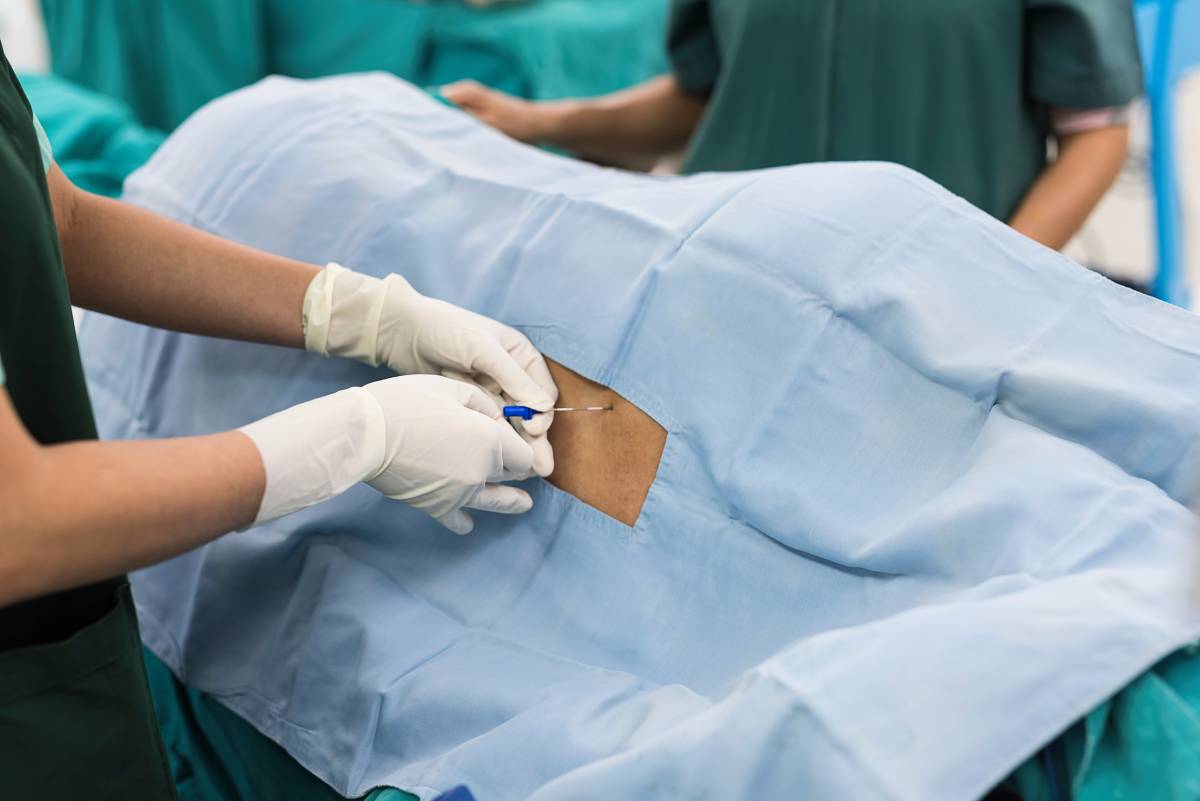Post dural puncture headache (PDPH), also referred to as post lumbar puncture headache, is a frequent complication arising from diagnostic lumbar puncture. It can also occur after spinal anesthesia or, more commonly, from accidental dural puncture during an epidural catheter placement attempt. The headache is typically positional, becoming worse when standing and improving when lying down. PDPH is often associated with neck stiffness, sensitivity to light (photophobia), nausea, or subjective hearing symptoms. In some cases, symptoms can be debilitating, requiring medical intervention. One such intervention for PDPH is an invasive treatment known as an epidural blood patch (EBP).
The exact cause of headache following a dural puncture is not entirely understood, but it is believed to be related to the leakage of cerebrospinal fluid (CSF) through the dural hole made by the needle. If CSF leaks faster than it is produced, low CSF pressure can occur, which is more pronounced at the level of the brain when in an upright position. However, not all patients with PDPH have low CSF pressure, and not everyone with a significant CSF leak develops a headache. The incidence of PDPH varies greatly, depending on patient-specific and procedural risk factors. After spinal anesthesia, it is between 3% and 9%, depending on the type and size of the needle used. After lumbar puncture, it occurs in about 11% of cases.
The treatment of PDPH depends on the severity of the headache and its effect on the patient’s ability to function. Patients with PDPH who cannot tolerate sitting or standing, who are unable to carry out daily activities, or whose headache does not respond to a short trial of conservative measures are considered to have moderate to severe PDPH. These patients should be offered an epidural blood patch, which may provide lasting symptomatic relief.
An EBP is a procedure where a small amount of the patient’s own blood is injected into the epidural space to seal a CSF leak. Epidural blood patch is regarded as the definitive treatment for PDPH. A systematic review by Boonmak et al., published in 2010, found that EBP reduced the duration and intensity of post-dural puncture headache compared to both conservative treatment and sham procedures. EBP typically provides immediate relief. The success rate after the first EBP is between 65% and 98%, with a similar success rate for a second EBP if needed.
Similar to epidural anesthesia, an epidural blood patch is contraindicated for patients with coagulopathy, those on anticoagulants, and patients with systemic infections or infections at the epidural needle insertion site. The EBP procedure involves injecting the patient’s blood into the epidural space using an epidural needle. The needle is inserted as it would be for epidural anesthesia, using the loss of resistance to saline technique to locate the epidural space without inserting a catheter. Once the epidural space is identified, a second operator draws a syringe of the patient’s venous blood using aseptic technique, which is then slowly injected through the epidural needle. Headache symptoms typically improve within seconds to minutes after the procedure, although a temporary sensation of “fullness” in the back is common. After the EBP is completed, the patient is advised to lie flat for one to two hours with minimal movement. Following this period, the patient can stand and resume normal activities.
References
DelPizzo K, Cheng J, Dong N, Edmonds CR, Kahn RL, Fields KG, Curren J, Rotundo V, Zayas VM. Post-Dural Puncture Headache is Uncommon in Young Ambulatory Surgery Patients. HSS J. 2017 Jul;13(2):146-151. doi: 10.1007/s11420-017-9541-0. Epub 2017 Mar 16. PMID: 28690464; PMCID: PMC5481263.
Choi PT, Galinski SE, Takeuchi L, Lucas S, Tamayo C, Jadad AR. PDPH is a common complication of neuraxial blockade in parturients: a meta-analysis of obstetrical studies. Can J Anaesth. 2003 May;50(5):460-9. doi: 10.1007/BF03021057. PMID: 12734154.
Vallejo MC, Mandell GL, Sabo DP, Ramanathan S. Postdural puncture headache: a randomized comparison of five spinal needles in obstetric patients. Anesth Analg. 2000 Oct;91(4):916-20. doi: 10.1097/00000539-200010000-00027. PMID: 11004048.
Boonmak P, Boonmak S. Epidural blood patching for preventing and treating post-dural puncture headache. Cochrane Database Syst Rev. 2010 Jan 20;(1):CD001791. doi: 10.1002/14651858.CD001791.pub2. Update in: Cochrane Database Syst Rev. 2013;11:CD001791. PMID: 20091522.
Abouleish E, Vega S, Blendinger I, Tio TO. Long-term follow-up of epidural blood patch. Anesth Analg. 1975 Jul-Aug;54(4):459-63. doi: 10.1213/00000539-197554040-00012. PMID: 125053.
Paech MJ, Doherty DA, Christmas T, Wong CA; Epidural Blood Patch Trial Group. The volume of blood for epidural blood patch in obstetrics: a randomized, blinded clinical trial. Anesth Analg. 2011 Jul;113(1):126-33. doi: 10.1213/ANE.0b013e318218204d. Epub 2011 May 19. PMID: 21596867.
Banks S, Paech M, Gurrin L. An audit of epidural blood patch after accidental dural puncture with a Tuohy needle in obstetric patients. Int J Obstet Anesth. 2001 Jul;10(3):172-6. doi: 10.1054/ijoa.2000.0826. PMID: 15321606.
